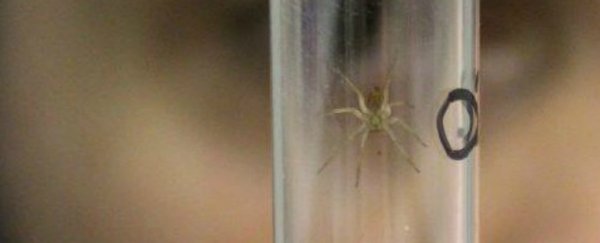Researchers at the Chessington World of Adventures zoo near London have released 400 fen raft spiders into the wild over the past four years in an effort to save the species from extinction.
Now, their work has finally paid off, because the team has recently announced that the wild fen raft spider population has rebounded enough that they can stop breeding them in captivity and let nature take its course.
The zookeepers had been breeding the spiders in captivity since 2011. Through their efforts, the wild population has nearly doubled, winning the team a gold conservation award from the British and Irish Association of Zoos and Aquariums (BIAZA).
Fen raft spiders (Dolomedes plantarius) can grow to an intimidating 7.6 centimetres (3 inches) long, but the good news is they want nothing to do with us humans, choosing to spend most of their lives in marshes where they eat an assortment of other spiders, tadpoles, and even small fish.
Despite the fact that the white-striped arachnids tend to avoid humans, humans can't seem to avoid them - thanks mainly to urban development, the species has been stripped of their homes, leaving them endangered.
"Fen raft spiders are a native of the UK; they are the largest spider that resides here - so large in fact that they eat fish!" the team reports. "However, fen rafts have become extremely rare in the UK and have been listed as endangered. This sadly dwindling population has largely been affected by human encroachment."
To stop the species from disappearing completely, the zoo started breeding spiderlings in the lab. Then, when they were old enough to fend for themselves, they were released into the wild.
Overall, the team has released approximately 400 new spiders into various areas to boost local populations, and it worked out better than they could have imagined.
"Wild numbers almost doubled during this time, and the programme was so successful that zoos no longer have to rear the spiders to keep the population up," the team says.
In the world of conservation, this is big news, because fen raft spiders play an important role in the ecosystems they inhabit by eating insects and getting eaten themselves. They were also one of the first creatures to get protection from the Wildlife and Countryside Act (1981), and breeding them is far from easy.
"The spiders are all kept in separate test tubes so they do not eat each other, and I have to individually hand feed them with fruit flies," lead keeper Karen Lambert, who hand raised the spiders, said back in 2012. "It's a very, very labour intensive job for that number of spiders but it's vital for the future of the species."
Lambert was required to spend about 2 hours every day alone with the spiders, ensuring their survival during their early years of life. "I'm helping see them through to adulthood before they are released as that will give them a much better chance of survival," she said.
So far, the spiders on inhabit three sites in the UK - Suffolk, East Sussex and Swansea - though the team hopes they will latch on to other areas in the future.
This isn't the first time researchers have reintroduced zoo-bred animals into the wild. In fact, reintroduction one of the most common conservation methods, reports the Association of Zoos and Aquariums (AZA).
"Reintroduction programs, by which animals raised or rehabilitated in AZA-accredited zoos or aquariums are released into their natural habitats, are powerful tools used for stabilising, re-establishing, or increasing in situ animal populations that have suffered significant declines," says the AZA.
Through these methods, species like black-footed ferrets, California condors, and freshwater mussels have all been saved.
While it will take some time to know whether or not the fen raft spiders will ever get off the endangered list, the fact that the zoo no longer feels that the need to breed them is definitely good news. Now, we'll just have to wait and see… from a safe distance.
